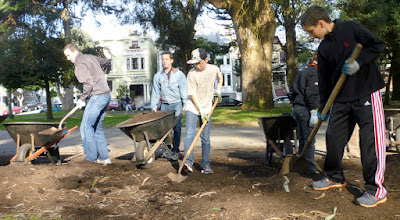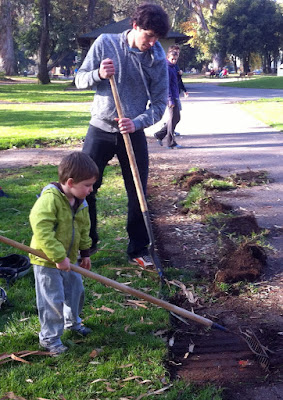A few weeks ago, the AIDS Walk brought thousands of people to Golden Gate Park. By midday, thousands of people were on the hunt for a place to sit for a rest or to have a bite to eat. One convenient place is to settle down next to, or on, a statue or monument.
 |
| Picnicking in Golden Gate Park |
In the Panhandle, the McKinley Monument is put to similar use on a daily basis. It's actually put to use in a lots of other ways- toddlers learning to climb, little kids kicking a ball with parents, neighbors meeting up with friends for a bike ride, reading a book, or getting some sun.
But the monument is in disrepair.
In June, when I saw a team of restoration experts hired by the city to remove graffiti, I asked about the job in front of them, and they said their current job would only be to remove some graffiti and apply a sealant. They pointed out the signs that water from rainfall is getting into the base upon which the bronze statue rests. They also pointed out how the gaps between the stones steps leading up to the monument are open and filled with weeds. I had already noticed that the
bas-relief of McKinley was discolored from corrosion. But there is not a plan to fund maintenance or restoration of all of public artworks in San Francisco, and it appears that that the McKinley is lacking a benefactor. In the
San Francisco Chronicle on July 16, 2011,
a front page article by Stephanie Lee reported on the restoration of a large, 40-year old outdoor sculpture at the Hall of Justice that had just concluded at the cost of $35,000. The article reported that other artworks around San Francisco were in need of funding plan (public or private) "Robert Ingersoll Aitken's 1904 William McKinley statue in Golden Gate Park needs a heavy coat of protection over its bronze and stone that could cost as much as $165,000."
 |
McKinley waiting for more than graffiti removal |
Beyond repairing and restoring the monument itself, Alison Cumming of the SF Arts Commission
told a committee in January about chronic, recurring vandalism of the monument, and said that her office would like to work with the Recreation and Parks department "to address solutions, including possible
replanting of the area, up-lighting, and period-appropriate fencing" at the McKinley Monument.
Allow me a few comments on these possible changes:

1.
Replanting of the area could really help. Right now, there is just weedy grass, and it's in poor shape, worsening in the dry season. This group has made efforts to remove debris and spread some healthy soil to allow new grass to sprout, but it would be so much better to have some nice plants. Throughout the east end of Golden Gate Park, statues and monuments typically have some decorative plantings (like the picture at top).
2.
Uplighting the monument, if done in a comprehensive way, would be responsive to the concerns I have heard from neighbors about the darkness of the east end of the park. These neighbors have noted that the eastern end was underserved by the lighting that was installed throughout the rest of the park several years ago, and believe that the poor lighting contributes to more criminal activity, vandalism, and drinking/drugging. They are also concerned that along dark pathways, there's a greater risk of injuries due to bike-bike or bike-ped collisions. I would hope that lighting would not be limited to lights shining only onto the monument itself, but would be accompanied by lighting along the eastern perimeter of the park and at the beginnings of the north and south pathways.
3.
Fencing the monument would be a big change, but there are ways to mitigate the negative impacts. It would be a loss to eliminate the positive, harmless ways people play on or around the monument, but a barrier may be necessary, given the ongoing problem with vandalism, and with other lesser ways that people degrade the area (for example, by using it as a place to smoke or drink, or to set up a charcoal grill). I don't expect everyone will agree that those problems merit a fence, but I believe they are all degrading to the monument and that they all result in excluding others from the area, thus denying access to most for the pleasures of a few. But, there are some drawbacks to a fence, such as taking away the monument's steps as a place to sit. The lack of seating is another comment I've heard from neighbors. So, if a fence is built, it's going to be extremely important to add some kind of seating in the immediate area.
Despite some major controversies in the past about public artworks, San Francisco is in a phase of experimentation in its public spaces, and some of those experiments are beginning to literally touch its public sculptures. The Pioneer Monument - a huge piece that had to be relocated and eventually found a home in the middle of Fulton Street across from the main library - was fenced in years ago. Now, in addition to the fence, there's a bed of soil and mulch home to dozens of plants, bordered by a meandering wattle to keep the soil in place. It's all encircled by a low, stone seating wall that gives people a place to rest and watch life (and traffic) go by. If ideas like this can be implemented down in the Civic Center, then I think we can come up with even more creative ideas to protect and improve the artwork in our neighborhood park.








































